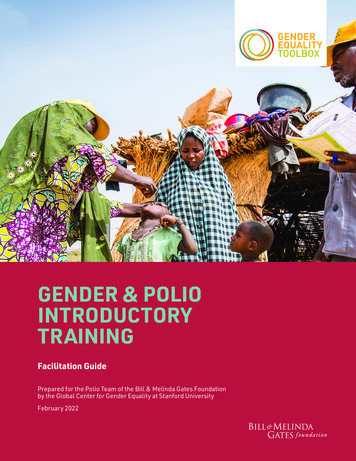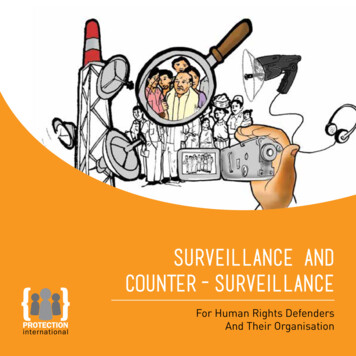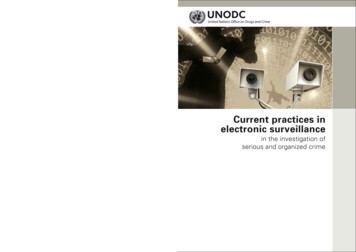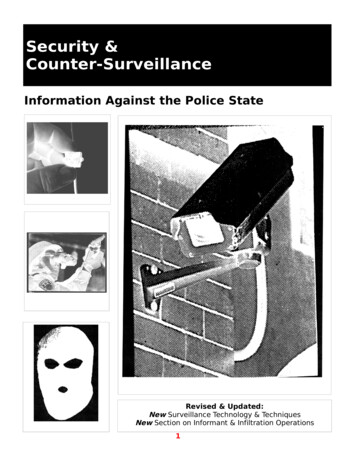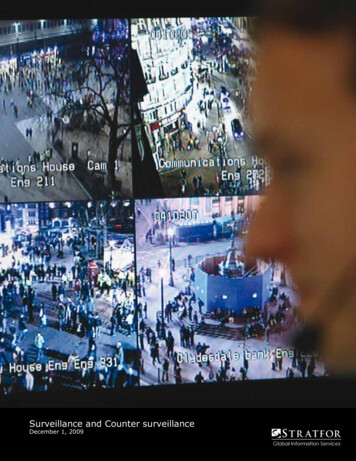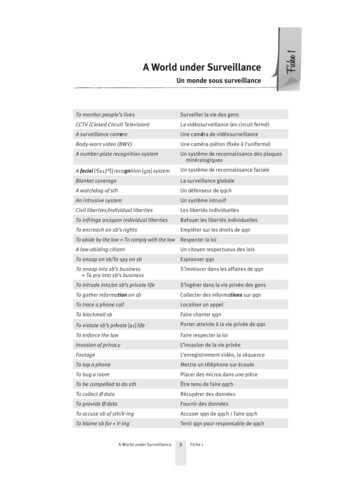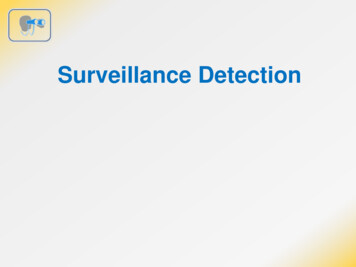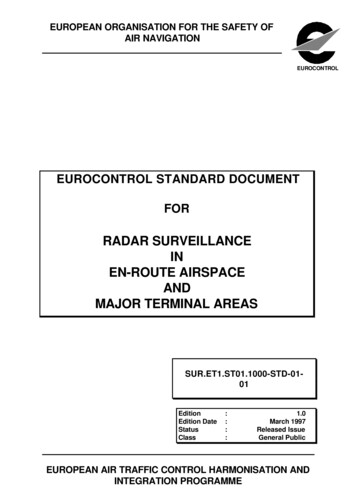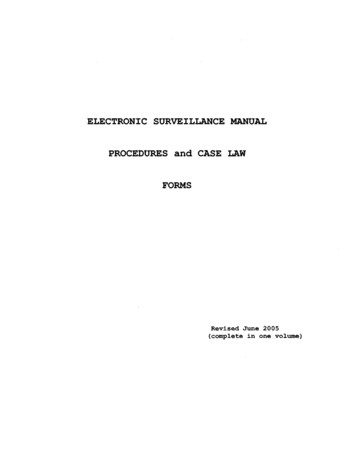![[Concept Note] Polio Environmental Surveillance Enhancement Following .](/img/60/es-obr-nopv2-revision-20200601.jpg)
Transcription
[Concept Note] Polio Environmental Surveillance EnhancementFollowing Detection of Vaccine-Related Type-2 Poliovirus1. Goal and Objective:Although acute flaccid paralysis surveillance is the gold standard of polio surveillance, supplementalsurveillance methods (which includes environmental surveillance (ES)) provide additional information toassess the extent of poliovirus circulation. The purpose of this concept note is to provide a foundation forthe development of a standard operating procedure for enhanced, reactive, short term ES to monitor forOPV2 virus (SL2) and VDPV2 pre- and post-outbreak response with monovalent OPV type 2 (mOPV2) ornovel OPV type 2 (nOPV2). The goal is to establish standard, minimum guidelines for monitoring thepresence or absence of vaccine-related virus through ES in special circumstances that can be adapted orbroadened depending on the specific situation.This document provides basic guidelines for polio ES enhancement following VDPV2 detection and isintended to serve as a basis for future development of more detailed Standard Operating Procedures orprotocols as necessary. Also, the proposed ES enhancement is meant to be qualitatively and quantitativelydifferent to previous “ES sweeps” in terms of site selection and frequency of sampling.2. Intended Audience:This document is intended for the various Global Polio Eradication (GPEI) working groups, to trigger thedevelopment of standard operating procedures.3. Background and Rationale:Following the global cessation of routine use of OPV2 in April/May 2016, immunity against infection withtype 2 poliovirus is on the decline. Since cessation, new VDPV2s have emerged causing events/outbreaksdue to ongoing transmission of OPV2-related viruses, suspected unauthorized use of trivalent OPV (tOPV),and use of type 2 monovalent OPV (mOPV2) for outbreak response. Risks of ongoing circulation of VDPV2smay also arise from immune-deficient, long-term VDPV excretors (iVDPV), or from circulating VDPV2(cVDPV2) released from a laboratory. Circulation of type 2 poliovirus requires an urgent response withmOPV2 to interrupt transmission. However, a response with mOPV2 carries the risk of seeding subsequentoutbreaks of vaccine-derived poliovirus (VDPV), which has been estimated to become greater over timedue to the accumulation of OPV2-naïve children. Per modelling estimates, even if campaign coverage isrelatively high in the response zone, connected (through geographic proximity and/or populationmovement) areas outside the response zone with OPV2-naïve individuals may be at risk of new VDPVtransmission (particularly 18 months after cessation). Although the overall risks of seeding new VDPV2outbreaks may be low and difficult to specifically quantify, if such events do happen the progress toeradication will be impeded. A potential consequence of uncontrolled cVDPV2 outbreaks includes theneed to restart OPV2 in routine immunization. In order to minimize this risk a new vaccine, nOPV2, isbeing rolled out in 2020 under a WHO emergency use listing (EUL). Studies to date have shown nOPV2offers similar levels of protection as mOPV2, but with significantly reduced risk of seeding new outbreaks.It is important to systematically enhance virus detection in/around areas when i) a VDPV2 is first reportedto inform the response; ii) a response with mOPV2 or nOPV2 is conducted to closely monitor the impactPage 1 of 8Version. June 2020
[Concept Note] Polio Environmental Surveillance EnhancementFollowing Detection of Vaccine-Related Type-2 Poliovirusof the response in interrupting VDPV2 transmission; iii) monitoring any inappropriate large-scale use ofmOPV2 or nOPV2 after the official response; and iv) monitoring persistence of SL2 within the responseregion or in connected areas at risk.ES for poliovirus supplements acute flaccid paralysis (AFP) surveillance and provides information on thepresence and spatial scale of wild PV and VDPV transmission. It has played a critical role in monitoringcVDPV2 transmission and SL2 isolation from the mOPV2 responses in Nigeria and Pakistan post-OPV2cessation. Furthermore, the GPEI ‘standard operating procedures’ for responding to a type 2 poliovirusevent or outbreak state that ES should be considered to enhance surveillance following detection of type2 poliovirus. For example, in scenarios where newly isolated VDPVs have an ambiguous definition (i.e.when a VDPV has only been isolated from a single AFP case or ES sample), ES can help determine theextent of virus circulation to inform the type of response required. Realizing the importance of ES in thepost-cessation period where VDPV2 circulation and mOPV2 response carry increasing risks, the CessationRisk Task Team (CRTT) requested the ESIWG to provide a concept note on the potential role of ES duringa VDPV2 detection and response. This June 2020 version is an update of that note, originally published inMay 2018, to include nOPV2.4. Limitations of the Document:The explicit breakdown of costs, personnel, and overall management have not been considered in detailat this stage.Although important, the following scenarios are not covered by this document:I.II.III.Monitoring in hard-to-reach or security-compromised areasMonitoring in mass-gatheringsMonitoring following a facility/laboratory breachFurthermore, it will be necessary to build on the lessons learned through this approach, and extend theguidelines to detect OPV-1, and -3 with respect to bOPV cessation at a later date.Note that this document is not a standard operating procedure.5. General GuidelinesThese guidelines should be implemented following a consensus by GPEI technical partners and nationalgovernments that ES would be appropriate and feasible for the given situation. It is envisioned thatmembers of relevant GPEI groups, such as GPLN, OPRTT, STT, and ESIWG, in coordination with Countryand Regional WHO staff and government counterparts, would be responsible for the feasibilityassessment and implementation of the guidelines discussed here. The feasibility assessment should takeinto account both i) the ability to rapidly identify suitable sites for the collection of environmental samples;and ii) the capacity to rapidly train collectors and prepare laboratories in time (identifying existing labsthat can receive additional specimens). Outside of an outbreak response, implementing i) and ii) can takemonths to set-up; therefore, pre-training an ES outbreak response team that could be deployed to workwith local personnel in an outbreak area could be considered (i.e. this could be included within the surgePage 2 of 8Version. June 2020
[Concept Note] Polio Environmental Surveillance EnhancementFollowing Detection of Vaccine-Related Type-2 Poliovirusof capacity at the start of the outbreak). Local personnel will be essential to provide local knowledge andnot attract unwanted negative attention in high-risk settings.The proposed enhanced ES is context-specific and refers to either enhancing the scope of existing ES inthe country/region or initiating ES in a temporary manner for a defined time-period.AFP surveillance will remain critical during type 2 events and outbreaks and the ES surveillance proposedhere should not compromise the quality of AFP (and community) surveillance or the quality of anyoutbreak response campaigns.5.1. Operational Framework for the Establishment of ES:An overview of the decision process in determining the enhancement or deployment of ES is given inFigure 1 and is described in more detail below. The duration, frequency, and geographical scale ofsampling, which are summarized by Figure 2 (with further details given in sections 5.4 and 5.5), will bedetermined by the type of VDPV2 isolated.Figure 1 Overview of decision process to determine the enhancement or deployment of ES following a new VDPV isolationPage 3 of 8Version. June 2020
[Concept Note] Polio Environmental Surveillance EnhancementFollowing Detection of Vaccine-Related Type-2 PoliovirusFigure 2 Overview of timeline of enhanced environmental surveillance (ES) depending on the type of initial VDPV2 isolated1. In areas with existing ES sites:a. No change if existing number of sites and frequency of collection are assessed to beadequate (in terms of geographic scope and frequency, see sections 5.4 and 5.5) in thecontext of the outbreak and its response. The minimum recommended samplingfrequency is monthly per ES site; however, this might not be adequate in the context ofan outbreak.b. If existing number of sites and frequency of collection are assessed to be inadequate inan outbreak context, consider:i. Increasing sample collection frequency to twice monthly (or every two weeks),following discussion with Regional Office (RO) and partnersAnd / or,ii. Increase the number of sites following assessment by the RO and partners:1. If the potential area of active outbreak, or the area of response is not wellcovered by existing ES sites. For example, the capital or major city of eachadministrative unit surrounding the initial detection location could beconsidered for sampling.2. If the population at risk is not adequately covered by current ES sites.Page 4 of 8Version. June 2020
[Concept Note] Polio Environmental Surveillance EnhancementFollowing Detection of Vaccine-Related Type-2 Poliovirusc. If the ES quality indicators (see section 5.2) are currently not being met, an investigationinto the cause of the poor quality of sampling should be performed to identify how thequality can be improved.d. Any changes must be coordinated with the laboratory and regional office to ensurefeasibilityIssues: 1) b (i and ii) should ideally be decided within two weeks of a VDPV isolation / outbreakconfirmation; with implementation occurring 2 weeks later and / or within 2 weeks of an outbreakresponse vaccination campaign2) Capacity of the reference laboratory/ies to process samples in a timely manner with optimum qualityshould be taken into consideration in finalizing the number of samples / sites in response to the outbreak.For reference labs that are outside the country, shipment and sample handling need to be coordinatedbased on any precedent or current feasibility.2. In areas without existing ES:a. Immediate: Assess feasibility and need of ES deployment (within 2 weeks of type 2poliovirus isolation), by RO and partners. Part of the feasibility assessment would includea site visit by an experienced ES person to identify whether potential locations to samplefrom exist.b. If feasibility/need is confirmed, conduct ES sampling from at least 3 different sites everytwo weeks (ideally within 2-4 weeks of every response) and continue for at least sixmonths after last mOPV2 or nOPV2 vaccination campaignc. Use a method of sampling depending on assessment of local factors, feasibility of sampleshipment, reference laboratory capacity, and epidemiologic situation.Issues: 1) Capacity of the laboratory/ies to process samples in a timely manner with optimum qualityshould be taken into consideration in finalizing the number of samples / sites in response to the outbreak.2) For countries/regions with limited/no lab capacity for prompt expansion, consideration for shippingsamples or (BMFS) filters to a reference lab should be included in the initial assessment.3) The feasibility assessment should consider the ability to train collectors, identify suitable sites, andprepare laboratories for a timely response.The minimum recommended sampling frequency is monthly per ES site; any changes to the samplingfrequency or adjustments in the overall ES network (i.e., opening new sites) should be discussed andcoordinated with the GPEI partners in coordination with Country and Regional WHO staff andgovernment counterparts, for feasibility.5.2. Ensuring the Quality of ES:1) Site selection and validation: New sites to be established on an ad-hoc basis need to be validated.Validation criteria (to be defined) should include the site selection process (standards to befollowed).Page 5 of 8Version. June 2020
[Concept Note] Polio Environmental Surveillance EnhancementFollowing Detection of Vaccine-Related Type-2 Poliovirus2) Site quality indicators: Sites should detect NPEV or poliovirus in at least 50% of samples in a sixmonth period to have a reasonable sensitivity. If virus isolation is less, possible reasons for thisshould be investigated and changing of sampling sites should be considered. In addition, thestandard ES process indicators should be followed (e.g. 80% of scheduled samples should becollected and 80% of these should arrive in a lab in good condition).3) Tools:i.Existing grab sampling and standard WHO algorithm for poliovirus isolation where ES isestablished under the global ES expansion plan.ii.In addition to the two-phase method, bag mediated filtration systems (BMFS) and otherfiltration methods may be considered where needed, and with necessary adaptations, ifapplicable (such as the “bucketing” protocol for areas with security concerns) i.e. i) in anarea/country with no existing ES infrastructure; ii) where rapid, small-scale deploymentis considered essential; or iii) in areas with special need such as sporadic access due tolocal factors, where enhanced sensitivity or collecting/testing larger volume of samplescould be critical relative to other factors.5.3. Limitations of “Ad Hoc” ES ApproachPer GPEI guidelines, ES sites are ideally placed in areas with convergent sewage networks, where samplingcan be done at inlets to sewage treatment plants, pumping stations or other major sewage collectors,covering a population of approximately 100,000 to 300,000, with variations depending on the setting andepidemiological need. Given these standards and the conditions in the highest-risk areas, it is possible—even likely—that suitable sampling sites will not be available near a new VDPV2/SL2 detection. However,epidemiological or contextual need, such as high risk of undetected spread, may allow some compromisein site selection, so long as the expansion does not put unreasonable burden on the laboratory andprogram, and sites are closed if not useful.Although the triggers for expanding the elective pattern of ES establishment to incorporate more reactive,“ad hoc” sampling is recognized in the current context, such an approach will have inherent limitationssuch as lack of standardization and comparability with a known baseline (i.e. the value of a negative resultis unknown and unknowable), challenges related to prompt selection and deployment of ES sites andtools, and variance related to sensitivity dependent on timing, seasonality, and local factors.5.4. Interpretation of resultsPositive results will be informative to monitor VDPV2 circulation and the impact of a response, as outlinedabove. However negative results should not be interpreted as evidence for the absence of virus. Ingeneral, estimating the negative predictive value of such an approach is limited given the relatively smallnumber of samples. Negative results should be cautiously used to avoid disturbance of establishedpoliovirus surveillance systems.5.5. Options for ES Following an Initial Ambiguous/Unclassified VDPV2 Isolation:Objective(s): Monitor to determine whether there is evidence of transmission of a recently isolatedaVDPV2 or iVDPV2 to inform whether a response is required. (Although one-off VDPV2 isolations havebeen common in the past and have not led to outbreaks, there is a greater need, in the coming months toPage 6 of 8Version. June 2020
[Concept Note] Polio Environmental Surveillance EnhancementFollowing Detection of Vaccine-Related Type-2 Poliovirusyears, to quickly determine if the virus is circulating given the increase in risk of potential transmission asthe cohort of susceptible children grows. A response with mOPV2 may be more detrimental than beneficialif a VDPV2 is not circulating, hence the need to increase surveillance).Guidelines:1) Duration: Broadly, the enhancement or deployment plan should include monitoring for at leastsix months from the initial VDPV2 detection.2) Frequency: Minimum recommended sampling frequency is monthly; where feasible and withconsultation, consider sampling every two weeks3) Stopping / continuation trigger:i.No further VDPV2s are isolated throughout the six-month period from all types ofsurveillance and mOPV2 is not administered: stopii.Genetically linked VDPV2s are isolated from AFP cases, AFP case contact sampling, or ESsamples and/or an mOPV2 or nOPV2 response is initiated: transition to protocol for ESfollowing an outbreak response (see section 5.6).4) Geographic scope: As a minimum the closest urban area of the first administrative level (ADM1)in which the VDPV occurred should be sampled (with a population 100,000 people). In addition,other large urban areas ( 100,000 people) of adjacent ADM1s could be considered depending onthe local epidemiology (note this may fall across neighboring countries). If these cities are notlarge enough, the closest feasible city with a population 100,000 should be considered, takinginto account the feasibility to transport specimens to the lab. The ‘closest’ urban area should bedefined by local knowledge of population movement as well as distance.5.6. Options for ES Following Confirmation of a cVDPV2 Outbreak:Objective(s): Monitor i) the geographical extent of cVDPV2 transmission to verify that the scale of theplanned response is appropriate; ii) duration and geographic extent of SL2 excretion following mOPV2 ornOPV2 use (to confirm mOPV2/nOPV2 is used appropriately); iii) detect early evidence of the emergenceand transmission of new VDPV2s that may result from mOPV2 or nOPV2 use; and iv) supplement AFPsurveillance (and existing ES) to confirm interruption of the outbreak as needed.Guidelines:1) Duration: Broadly, the enhancement or deployment plan should (i) be started within 2-4 weeksof every response, and (ii) include monitoring for at least six months following the last use ofmOPV2 or nOPV2 in the affected area.2) Frequency: Minimum recommended sampling frequency is monthly; where feasible and withconsultation with appropriate GPEI, WHO RO/CO, and national counterparts, consider samplingevery two weeks until at least six months after last mOPV2 or nOPV2 use3) Stopping / continuation trigger: Stop after at least six months from last mOPV2 or nOPV2 use4) Geographic scope: This is difficult to pre-define and should be strategically defined, based oncountry context and knowledge of previous poliovirus circulation and population migrationpattern. Nonetheless it should be broad in general, and consider the following:Page 7 of 8Version. June 2020
[Concept Note] Polio Environmental Surveillance EnhancementFollowing Detection of Vaccine-Related Type-2 Poliovirusa.The closest urban area ( 100,000 people) within the ADM1 of outbreak case or ES site(where closest may be defined by distance or local knowledge of population movement)b.Major cities within the response zone and cities of ADM1 units adjacent to response zones(including areas in neighboring countries that fall within this definition). Major cities aredefined as those 100,000 people.c.If new and genetically related cVDPV2 viruses are isolated from a geographically differentlocation to the original outbreak location, new sites should be added given the change inthe geography of transmission, if deemed feasible to implement. The location of new siteswill be informed by the local knowledge of population movement.6. AbbreviationsAFPADM1aVDPVacute flaccid paralysisadministrative level 1ambiguous vaccine-derived poliovirusCOCRTTcVDPV1/2/3ESEOMGWHO country officeCessation Risk Task Teamcirculating vaccine-derived poliovirus type 1/type 2/type 3environmental surveillanceEradication and Outbreak Management GroupESIWGGPEIGPLNiVDPVNPEVEnvironmental Surveillance and Implementation Working GroupGlobal Polio Eradication InitiativeGlobal Polio Laboratory Networkimmunodeficiency-associated vaccine-derived poliovirusnon-polio enterovirusbOPVmOPV2nOPV2bivalent OPV (contains Sabin types 1 and 3)monovalent OPV (contains Sabin type 2)novel OPV type 2OPRTTOPVOutbreak Preparedness and Response Teamoral polio vaccineROSL2SOPSTTWHO regional officesabin-like poliovirus type 2standard operating procedureSurveillance Task TeamVDPVvaccine-derived poliovirusPage 8 of 8Version. June 2020
[Concept Note] Polio Environmental Surveillance Enhancement Following Detection of Vaccine-Related Type-2 Poliovirus Page 6 of 8 Version. June 2020 2) Site quality indicators: Sites should detect NPEV or poliovirus in at least 50% of samples in a six-month period to have a reasonable sensitivity. If virus isolation is less, possible reasons for .
